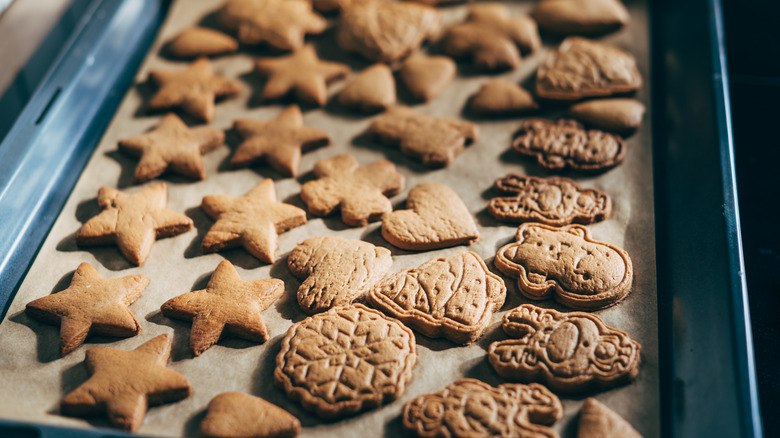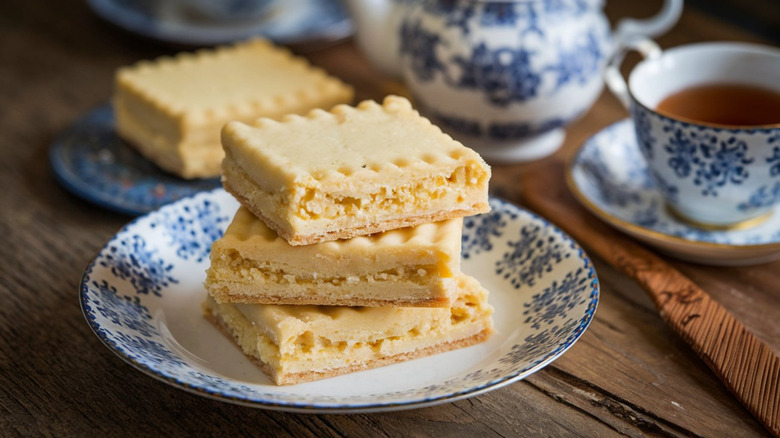The Actual Difference Between Cookies And Biscuits
When handed a sweet, it's reasonable to bite in and enjoy, without stressing over the name of the food. Yet desserts uphold tradition, and for favorites like cookies and biscuits, differentiation gets tricky. After all, picture these common sweets, and the image that comes to mind is of a small, round dessert, sourced either out of the oven or a tin. Especially once the holidays roll around, you might notice that varying biscuit bakes all get categorized under the Christmas cookie umbrella, further adding to the confusion.
As it often goes with nomenclature, overlap occurs. The truth is, a central cause of confusion can be attributed to geography. For Americans — especially in the South — a biscuit refers to a small, fluffy baked bread, prepared with leaveners and used to accompany a savory meal. Meanwhile in the U.K., a biscuit is a small, crumbly, sweet; a baked good with more semblance to a cookie. On this same side of the Atlantic, an American-style biscuit is called a scone. To top it off, Americans refer to British-style biscuits in the cookie umbrella — hence the Christmas mix-up!
Yet in the texture, flavor, and manner of preparation, sweet biscuits and cookies do offer some nuanced differences. Keep the variance in mind, and next time you're using a biscuit cutter for round cookies, you'll confidently handle the distinction — not to mention avoid an ordering mishap in the U.K.
Cookies utilize a soft dough embellished with filling and decorations
Oh, the comforting joy of a cookie. Whether you imagine a classic recipe like a chocolate chip or a more creative tamarind and lime thumbprint cookie, the sweet recalls several overarching characteristics. It's usually (not always) circular, not too tall, and comes with lightly curved sides. Apart from modern inventions like the cookie cake, a cookie isn't meant for splitting; rather, it's a (thankfully) self-contained treat — a quality that overlaps with biscuits.
By way of their less intricate composition, most do not count cookies as a pastry. Instead, the consistency is formed by a reliable mixture of butter, eggs, sugar, flour, and maybe a bit of milk. Right after baking, cookies delight with their gooeyness, then subsequently crisp as they cool. Unlike the crispy British biscuit, cookies are usually intended to offer some softness, hence why they're often enjoyed fresh. While bakers do experiment with the sweet's internal texture, the cookie's versatility really shines through its integration of further ingredients.
In addition to immediately noticeable chunky components like fruit, oatmeal, coconut, sweets, and more, cookies employ varying types of sugar and mix in foodstuffs like peanut butter. Much like a British-style biscuit, cookies also serve as a charming canvas for decorations. Whether beautifully colored with icing, dusted with sugar, or filled with jam, these baked sweets pop by way of the components added. So typically, expect a cookie recipe to be straightforward in its composition, yet bursting with delicious elements.
Biscuits refer to either a crispy British sweet or an American-style bread
Undeniably, the sweet type of biscuit and cookie share a lot in common. When speaking broadly in American English, the term often gets used interchangeably for the small, doughy creations. Yet start examining on a recipe basis, and the nuance becomes clearer. For one, opposed to the more set-in-stone egg and butter cookie dough, biscuits cover a wide range of ingredients.
The simplest shortbread biscuits use even fewer elements than a cookie dough, mixing up only butter, flour, and sugar into a crisp yet crumbly creation. These will hold structure in a wide range of shapes, but are often formed into rectangular logs rather than circles. Meanwhile, tea biscuits attain their airier and taller composition by way of baking powder, mixed in with pantry staples like flour, shortening, and milk. They're served with jam or dipped whole into a mug of tea; a sturdiness created for this specific application.
You're probably already familiar with the crispy, spiced delight of a gingersnap. Here, it's a marriage of baking soda, flour, eggs, and butter that creates the distinct composition. British-style biscuit recipes only keep going, but what unites the styles is a typically one-note flavor, paired with a brittle consistency — a contrast to a cookie's tender composition. Top them with icing, decorate with jam, or enjoy standalone; they're a delicious sweet of a unique style.



